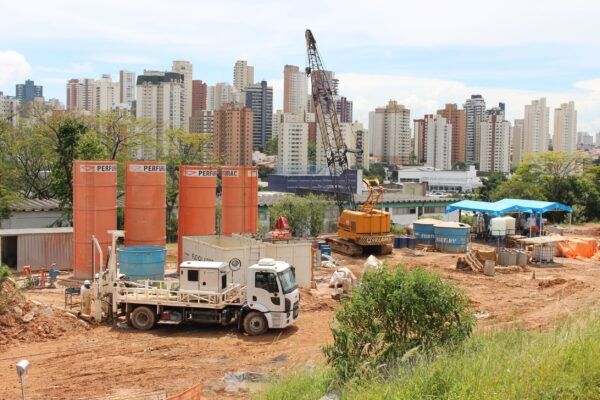Provect-IR® Antimethanogenic ISCR (In Situ Chemical Reduction) Reagent

 Provect-IR® is a unique mixture of reagents combined into a single product that optimizes the in-situ reductive dechlorination of chemicals present in soil, sediment, and groundwater. It acts by promoting synergistic interactions between:
Provect-IR® is a unique mixture of reagents combined into a single product that optimizes the in-situ reductive dechlorination of chemicals present in soil, sediment, and groundwater. It acts by promoting synergistic interactions between:
- Natural antimethanogenic compounds
- Hydrophilic, nutrient rich organic carbon sources
- Zero-Valent Iron (ZVI)
- Chemical oxygen scavengers
- Vitamin and mineral sources
This distinctive, patented combination of natural and food-grade chemicals promotes ISCR conditions for fast and effective destruction of targeted constituents of interest such as chlorinated solvents, organochlorine pesticides, and other halogenated compounds. Notably, Provect-IR is the only ISCR reagent to simultaneously inhibit the production of methane during the requisite carbon fermentation processes. This promotes more efficient use of the hydrogen donor while avoiding negative issues associated with elevated methane (CH4) in groundwater, soil gas, and indoor air. Current regulations for methane in groundwater vary from ca. 10 to 28 mg CH4/L (Indiana Department of Environmental Management, 2014) with additional State regulations pending. Furthermore, remedial practitioners have subsequently been required to establish contingencies for conventional ERD/ISCR implementation in the event that methane exceeds specific groundwater thresholds. These contingencies often entail expensive and extensive systems for capturing and treating methane in soil gas/vapor captured via SVE systems.
- Controlling Methane at ERD and ISCR Applications (Pollution Engineering News, November 2014)
- "ISCR & Antimethanogenic Reagents: Technical Overview with Field-Scale Applications to Address CVOCs" by Andy Lowy - Focused Remediation Seminars Virtual Webinar | December 16th, 2021
- Leveraging Warm Water from Source Area Thermal Remedy for Synergistic Biotic and Abiotic Degradation of a CVOC Plume - By Dan Bryant, Duff Collins, and Jason House - Woodard & Curran (platform)
- Leveraging Warm Water from a Source Area Thermal Remedy for Synergistic Biotic and Abiotic Degradation of a Downgradient CVOC Plume - By Russell J. Hogdahl, PE and Dan Bryant, Woodard & Curran (poster)
- Advances in AMR Technology to control Excessive Methanogenesis - By Jim Mueller, Will Moody, Greg Booth (Provectus Environmental Products, Inc.) Mike Scalzi (IET) and Kevin Finneran (Clemson University)
- Please Contact Our Team to Discuss Treatability Study Design
Provect-IR Projects
-
Former Manufacturing Plant – São Paulo, Brazil
Posted on August 2, 2022Provect-IR® – In Situ Chemical Reduction (ISCR) of Chlorinated Solvent Source Area Site: Former Manufacturing Plant – São Paulo, Brazil Constituents of Interest: –Tetrachloroethylene (PCE), Trichloroethylene (TCE), cis-1,2-Dichloroethene (cis-1,2 DCE), Vinyl Chloride (VC), and 1,1,2,2-Tetrachloroethane (1,1,2,2-TeCA) Project Summary This site is a former appliance manufacturing plant located in São Paulo, Brazil that was contaminated due […]
Continue reading -
Former Dry Cleaner – Ocean City, New Jersey
Posted on June 10, 2021Provect-IR® – In Situ Chemical Reduction (ISCR) Reagents for Source and Dissolved Plume Remediation Site: Former Dry Cleaner – Ocean City, New Jersey Constituents of Interest: Tetrachloroethylene (PCE), Trichloroethylene (TCE), cis1,2-Dichloroethene (cis-1,2 DCE), and Vinyl Chloride (VC) Project Summary A former print shop and dry cleaner located in a residential Ocean City, New Jersey neighborhood […]
Continue reading -
Former Manufacturing Facility – East Orange, NJ
Posted on March 21, 2018Site: Former Manufacturing Facility – East Orange, NJ Constituents of Interest: Trichloroethylene, cis-1,2-Dichloroethene and Vinyl Chloride Lead Contractor: Innovative Environmental Technologies, Inc. (IET) Project Summary Soil and groundwater at a former manufacturing facility in East Orange, NJ were impacted by trichloroethylene (TCE), cis-1,2, dichloroethene (cis-1,2-DCE) and vinyl chloride (VC) due to historical releases. The geology […]
Continue reading



